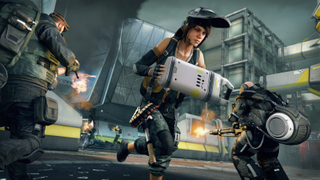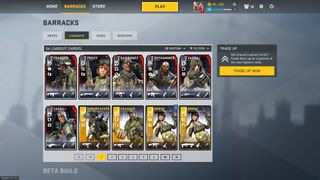You should be playing Dirty Bomb

We write about FPSes each week in Triggernometry, a mixture of tips, esports, and a celebration of virtual marksmanship.
At its peak, when some popular streamers and YouTubers were being paid to play it, Dirty Bomb was drawing as many as 13,000 concurrent players. I didn’t get swept up by that initial wave of attention, but I wish I had: Dirty Bomb, still in beta, is one of the best multiplayer FPSes you can play today.
I like its rhythm. I like its map flow. I like that one of the characters has an ever-replenishing grenade launcher that I never have to reload. Here’s why I think Dirty Bomb is worth your time.
It’s twitchy (if you want it to be)
Four of Dirty Bomb’s characters—Proxy, Sparks, Aura, and Kira—are as fast as anything you’ll lay hands on in an FPS. They’re fighter jets made of paper, fragile fast-movers with shotguns and SMGs that feel exhilarating when you string together kills.
More impressive is that Dirty Bomb can accommodate a motor skills-driven playstyle without being a game about speed and movement, unlike Tribes: Ascend or Titanfall. Turrets, proximity mines, and talented snipers can act as hard counters to quick characters, and there are enough others who don’t demand insane levels of brain-WASD agility to manage.
Best of all, the low recoil guns and the low deceleration penalty for jumping translates to excellent and tense “dances,” close-range duels where the movement decisions you make have a major impact on the result. Even with a medium-speed character like Skyhammer, below, I can often juke and crouch-dodge my way to victory.
It’s a Frankenstein of your favorite shooters
Comparing new FPSes to TF2 is an ancient tradition at this point, and Dirty Bomb does have a Turret Guy, a Large Minigun-Guy, and an Invisible Guy. It has a Payload-style map where one team has to repair, guide, and protect a vehicle through one stage of the level. But Dirty Bomb is also spliced with other popular FPSes. Execution Mode, which appeared for a short trial last month, is a single-life format where one team has to plant a bomb, not unlike CS:GO. The hit indicators, engagement ranges, and low recoil guns occasionally make Dirty Bomb resemble Call of Duty, and its medals system is borrowed from Battlefield.
But somehow, Dirty Bomb integrates these influences pretty gracefully. The aesthetic helps: Splash Damage imprints a near-future art style on UK architecture, and small-but-significant balancing decisions like the relatively high time-to-kill (compared to say, Counter-Strike) generally make for longer engagements.
PC Gamer Newsletter
Sign up to get the best content of the week, and great gaming deals, as picked by the editors.
It has a competitive mode
There’s a hundred reasons why League of Legends, Dota 2, and CS:GO are the most popular PC games in the world, but I don’t think anyone would disagree that bespoke ranked play is a key component of all three. It’s annoying that I can’t yet form a party with other players in Dirty Bomb for casual play, but you can play as a group or solo in its five-on-five mode, which opens up once you hit level five, which took me less than six hours.
Team composition matters more in competitive mode, individual kills matter more, and the game generally feels like less of a meat grinder. That isn’t a criticism of casual play—they coexist nicely and competitive mode simply presents a different style of Dirty Bomb.

The payment model is inoffensive
Dirty Bomb isn’t exempt from the chorus of “pay to win” accusations levied against almost every free-to-play game. But after playing for a couple weeks, I can’t say that I’m bothered by its pricing. You pay $7-10 to buy mercenaries (or a bunch of in-game currency), then use in-game currency (or pay $3.50) to unlock different, tiered loadouts of weapons or abilities for those characters. And like other F2P games, there’s a rotation of free mercs.
It’s difficult to get higher tier loadouts (silver, gold, or cobalt—80%, 15%, and 5% chance respectively in an individually-purchased, $5 “elite” case (which are cheaper as a bundle)), but these loadouts only grant you cosmetic distinction over other players, and even those aesthetic differences aren’t even that noticeable.
Standard loadout cases are pretty cheap, and similarly to CS:GO’s trade-up contract system, you can convert a handful of cards of the same quality into a random card of the next quality. In short, getting bronze-tier loadout cards of the mercs you like doesn’t take an unusual amount of effort or investment.

Evan's a hardcore FPS enthusiast who joined PC Gamer in 2008. After an era spent publishing reviews, news, and cover features, he now oversees editorial operations for PC Gamer worldwide, including setting policy, training, and editing stories written by the wider team. His most-played FPSes are CS:GO, Team Fortress 2, Team Fortress Classic, Rainbow Six Siege, and Arma 2. His first multiplayer FPS was Quake 2, played on serial LAN in his uncle's basement, the ideal conditions for instilling a lifelong fondness for fragging. Evan also leads production of the PC Gaming Show, the annual E3 showcase event dedicated to PC gaming.
Most Popular


